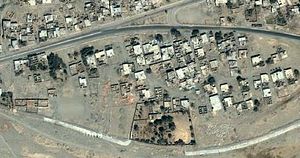Posted July 22.02

Berenike artifacts indicate a wide-ranging, cosmopolitan mix of people
South of Suez, the Egyptian shore of the Red Sea used to be sprinkled with ports that throbbed with life and commerce in antiquity, especially during the heyday of the Roman Empire.
But long ago, the relentless desert buried their remains. Under the sand lie pivotal links in a maritime trade route that rivaled the better-known overland Silk Road.
From here, ships ventured down the coast to Ethiopia, Somalia and beyond, bringing back ivory and tortoise shells, drugs and slaves. Other vessels headed for the southern shore of Arabia, mainly for frankincense and myrrh. The biggest ships sailed the monsoons to and from India to satisfy the bounding appetites in the Mediterranean world for spices, precious stones, and other exotic goods.
So robust was the India trade 2,000 years ago that Emperor Tiberius, concerned over Rome’s increasingly adverse balance of payments, complained that “the ladies and their baubles are transferring our money to foreigners.”
Perhaps the greatest of these ports in the Indian trade was Berenike, about 600 miles south of Suez, near Egypt’s border with Sudan. Historians knew of it from written records, yet nothing remained on the surface at the sere and forlorn site except some lines of coral and scattered potsherds. These were hardly sufficient to flesh out the bones of texts into a semblance of the seamen and merchants in their milieu at Berenike, in prosperity and decline over eight or nine centuries.
But archaeologists have now completed eight years of excavations under harsh conditions at Berenike and found what they say are the most extensive remains so far from the ancient world’s sea trade between East and West.
Jewels, peppercorns
The archaeologists’ spades uncovered building ruins, teak, and metal from ships, sailcloth, sapphires and beads, wine and stores of peppercorns. Some of the goods show that Berenike was trading, at least indirectly, with places as far away as Thailand and Java. Inscriptions and other written materials in 11 languages, including Greek and Hebrew as well as Latin, Coptic and Sanskrit, attest to the cosmopolitan mix of people who lived in or passed through the town.
The co-directors of excavations at Berenike – Steven Sidebotham, a historian at the University of Delaware, and Willeke Wendrich, an archaeologist at the University of California, Los Angeles – say the research showed that the maritime trade route between India and Egypt in antiquity appeared to be even more productive and longer-lasting than scholars had thought.
Also, it was not an overwhelmingly Roman enterprise, as had been generally assumed. The researchers say artifacts at the site indicate that the ships might have been built in India and probably had Indian crews.
“We talk today about globalism as if it were the latest thing, but trade was going on in antiquity at a scale and scope that is truly impressive,” Dr. Wendrich says.
The two researchers, working under the auspices of Egypt’s Supreme Council on Antiquities, reported their findings in this month’s issue of the journal Sahara. They also described their work in interviews and in a recent article in Minerva, a British magazine of ancient art and archaeology.
Other archaeologists praised the Berenike discoveries as important contributions to the history of long-distance trade in the classical world. Lionel Casson, an author and a retired professor of classics at New York University, says, “It’s nice to have archaeologists find concrete evidence for what is attested in the texts.”
In writings on early maritime commerce, the Indian Ocean’s role has been eclipsed by the richer body of literary and archaeological evidence for activity in the Mediterranean and Black seas. And the Silk Road, an Asian network of camel caravan routes, is legendary as the primary cultural and commercial link between China and Europe between about 100 B.C. and the 15th century.
“The Silk Road gets a lot of attention as a trade route, but we’ve found a wealth of evidence indicating that sea trade between Egypt and India was also important for transporting exotic cargo, and it may have even served as a link with the Far East,” Dr. Sidebotham says.
Transfer points
As developed by Greeks and Egyptians, then expanded by the Romans, the Red Sea ports served as transfer points for cargoes to and from India and other places in Africa and Arabia. Goods unloaded at the ports were hauled by camel train across the desert to the Nile, at Koptos, and carried by boat to Alexandria. From there they moved by ship to markets throughout the Mediterranean basin.
The course was reversed for exchange goods, wine and glass and fine tableware, bound for Indian Ocean markets.
Archaeologists are also investigating the probable sites of two other Egyptian ports, Myos Hormos and Nechesia.
At some ruins 100 miles north of Berenike, archaeologists led by John Seeger of Northern Arizona University, assisted by Dr. Sidebotham, are excavating a building from the first or second century A.D. It could be part of Nechesia, but no one can yet be sure.
David Peacock, an archaeologist at the University of Southampton in England, is more certain that he and colleagues have, by examining literary texts and satellite photographs, identified the site of Myos Hormos. It is 200 miles north of Berenike, near the present-day settlement of Quseir.
Excavations there were started in the 1980s by Americans under Don Whitcomb of the University of Chicago, and a British team under Dr. Peacock has worked there for the last four years. The place was definitely an ancient port, Dr. Peacock says, but it was not until an inscribed piece of pottery was recently uncovered that he could be sure “beyond reasonable doubt” that this was Myos Hormos.
Both Myos Hormos and Berenike, also known as Berenice, were established in the reign of Ptolemy II Philadelphus, in the early third century B.C., when Egypt was under Greek influence. Berenike was named after the ruler’s wife.
Writing in The Oxford History of Ancient Egypt, Dr. Peacock said: “It appears that Myos Hormos was pre-eminent during the second century B.C. and that Berenice began to rise in importance during the first century B.C. and became dominant in the first century A.D. The India trade was thus developed in Ptolemaic times and the Romans merely took over and perhaps expanded a well-established concern.”
Site rediscovered
The site of Berenike was rediscovered by European explorers in the early 19th century. But it was so remote from settlements and supplies that archaeologists shied away until Dr. Sidebotham and Dr. Wendrich came along in 1994. Their excavations revealed that Berenike experienced three periods of prosperity. The first was in the early Ptolemaic times, the third and second centuries B.C. Then after a century of decline, the port under the Romans enjoyed its second and greatest boom, in the late first century B.C. and through the first century A.D.
An enormous Roman rubbish dump, covering some of the Ptolemaic ruins, yielded a variety of ancient Indian goods, ranging from Indian coconuts and batik cloth to glass beads and gems. A pot held 16 pounds of peppercorns, one of the most common commodities. “If you find it in the trash, then the amount transported through the town must have been mind-boggling,” Dr. Wendrich says.
Dr. Sidebotham and Dr. Wendrich also reported finding a discarded customs archive, which was written on potsherds reused as a kind of notepaper. This revealed some of the trade procedures as well as goods.
The archaeologists were especially intrigued by the large amounts of teak, a hardwood native to India, found in the ruins. They surmised that the teak arrived as hulls of ships. When ships were damaged beyond repair, the teak was probably recycled in furniture or building materials. The presence of so much teak also suggested to the researchers that many of the ships were built in India, one of the indications of a major Indian role in the trade.
But Dr. Casson, a specialist in ancient maritime history, says it was also possible that the teak timber was shipped to Berenike and turned into vessels there. Written records refer to ships in the Indian trade being among the largest of the time. That means, Dr. Casson says, that they could have been as long as 180 feet and capable of carrying 1,000 tons of cargo. Such ships had stout hulls and caught the wind with a huge square sail on a stubby mainmast.
Mariners’ compass
An indispensable source of knowledge of the Indian trade is found in The Periplus Maris Erythraei, the circumnavigation of the Red Sea, a book written by an anonymous merchant or ship’s captain in about the first century. A recent translation and commentary were prepared by Dr. Casson and published in 1989 by Princeton University Press.
A practical guide to mariners, the book described the Red Sea ports in their prime and identified landmarks on the main trade routes. A round trip to India covered about 3,500 miles. Ships left Egypt in July to take advantage of strong summer winds out of the north in the Red Sea. Out in the open ocean, ships were carried by the southwest monsoon, bound for Arabia and across to India’s northwest coast, at the port of Barygaza, or headed directly across to Muziris on India’s southwest coast.
As the Periplus author wrote of the southwest winds, “The crossing with these is hard going but absolutely favorable and shorter.”
Returning, the ships usually departed in December or January to catch a favorable shift in winds. Still, they had to buck the prevailing northerly winds in the Red Sea. This was the reason the ports were several hundred miles south of Suez: better the long transfer of goods by camel and Nile boat than the battle against unceasing Red Sea winds.
The rewards must have more than compensated for the risks and hardships, historians conclude. At times when adversaries blocked the Silk Road, the Indian sea trade was the only reliable alternative. At all times, historians say, it cost less to ship by the sea route because it circumvented many of the Silk Road’s middlemen with hands out for bribes and commissions.
Yet the fortunes of Berenike were fickle, and it was long thought by historians that the port and town were abandoned in the third or fourth centuries. Then the archaeologists digging there came upon a surprise. Prosperity had returned for a third time to Berenike, in the fourth century. Dr. Wendrich reported finding that an entire area on the seaside was leveled and completely rebuilt and expanded.
Sometime before the mid-sixth century, though, Berenike, its harbor silted over, was finally abandoned for good, vanishing beneath the encroaching desert. The reasons are unknown.
• Story originally published by:
The New York Times via Dallas News / TX – July 22.02
